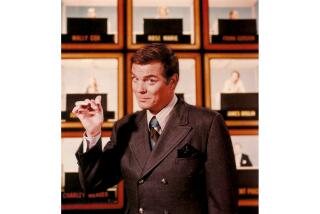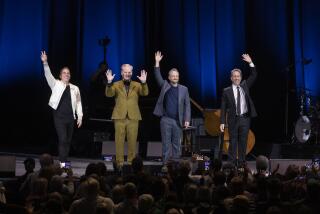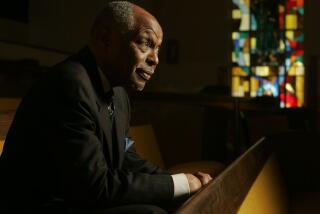Ken Murray, 85; Producer of WWII Revue, Actor
Ken Murray, the cigar-smoking vaudevillian whose racy “Ken Murray’s Blackouts” was one of the longest-running stage shows in history, died Wednesday morning at St. Joseph Medical Center in Burbank. Death was attributed to natural causes. He was 85.
Murray produced and starred in the World War II-era revue for more than seven years at the old El Capitan Theater on Vine Street in Hollywood, where the house was virtually always packed.
He also appeared in films and on television, making a name for himself as a Hollywood historian with home movies that he had shot of film stars over a 50-year period.
“Ken Murray’s Blackouts” (of 1942, 1943, etc.) featured bosomy Marie Wilson as the archetypical “dumb blonde” who delivered naive straight lines for Murray’s racy, cornball gags.
The audiences of servicemen and aircraft plant workers loved the show that most critics said wouldn’t last. It went 3,844 performances until 1949--when it moved on without Wilson to New York and folded in six weeks.
Murray, a longtime vaudeville performer who had made a few movies, launched “Blackouts” in 1942 with the help of sneeze comedian Billy Gilbert (who later gave way to young Cuban singer-drummer Desi Arnaz).
There were showgirls, skits, tap dancers, bird acts--and Marie Wilson.
Through it all was a crew-cut Murray, waving his long cigar and delivering his burlesque-banana lines. When Wilson told him she was born in an Anaheim grapefruit grove, Murray looked her over and said, “Well, that explains a couple of things.”
When Murray moved the show to Broadway, the New York critics were not amused. “Dismal” and “dreadful” were just two of their observations. Murray shut down, deciding he needed a rest.
In 1956, he and Wilson restaged “Blackouts” at the New Frontier in Las Vegas with new acts and new showgirls. It was a hit and played nightclubs and theaters throughout the country for three more years. It later ran for 17 weeks at the Ritz Theater in Los Angeles.
After that, Wilson appeared in nightclubs and films and on her own television show, “My Friend Irma.” She died in 1972.
The New York City-born Murray did concerts, television and movies. He found new success in the reel after reel of the home movies he had made around Hollywood.
“When I came West as a vaudeville actor on the Orpheum circuit in 1927,” Murray once told an interviewer, “it was my first time away from home. I was very close to my mom and pop--actually my grandparents, who brought me up--but I hated to write letters, so instead I bought a 16-millimeter home movie camera and sent back films.”
Murray’s grandmother carefully stored them, thus preserving countless casual shots of actors including Douglas Fairbanks Sr., Mary Pickford, John Barrymore, a young Gary Cooper, Jean Harlow in bell-bottom slacks and Charlie Chaplin falling on his bicycle while waving to Murray.
Eventually, Murray assembled all the footage, showing it on television as “Hollywood: My Home Town” and finally as a film called “Ken Murray’s Shooting Stars.”
In 1947, Murray received a special Academy Award for “artistry and patience” in producing a feature length film called “Bill and Coo,” in which he starred with a bird act from the “Blackouts” show.
Movies in which he appeared included “You’re a Sweetheart” (1937), “A Night at Earl Carroll’s” (1940), “Juke Box Jenny” (1942), “The Man Who Shot Liberty Valance” (1962), “Son of Flubber” (1963) and “The Power” (1968).
Among his television credits were “The Ken Murray Show” and “Where Were You?” He also wrote several books, including “Life on a Pogo Stick,” “The Golden Days of San Simeon” and “The Body Merchant.”
Murray, who was born Don Court, leaves his wife of 39 years, Bette Lou of Beverly Hills; their two daughters, Pam Godsick and Jane Green, as well as a son, Cort, by an earlier marriage.
In lieu of flowers, the family suggests that donations be made to the Motion Picture and Television Fund.
Funeral services were pending.
More to Read
The biggest entertainment stories
Get our big stories about Hollywood, film, television, music, arts, culture and more right in your inbox as soon as they publish.
You may occasionally receive promotional content from the Los Angeles Times.










